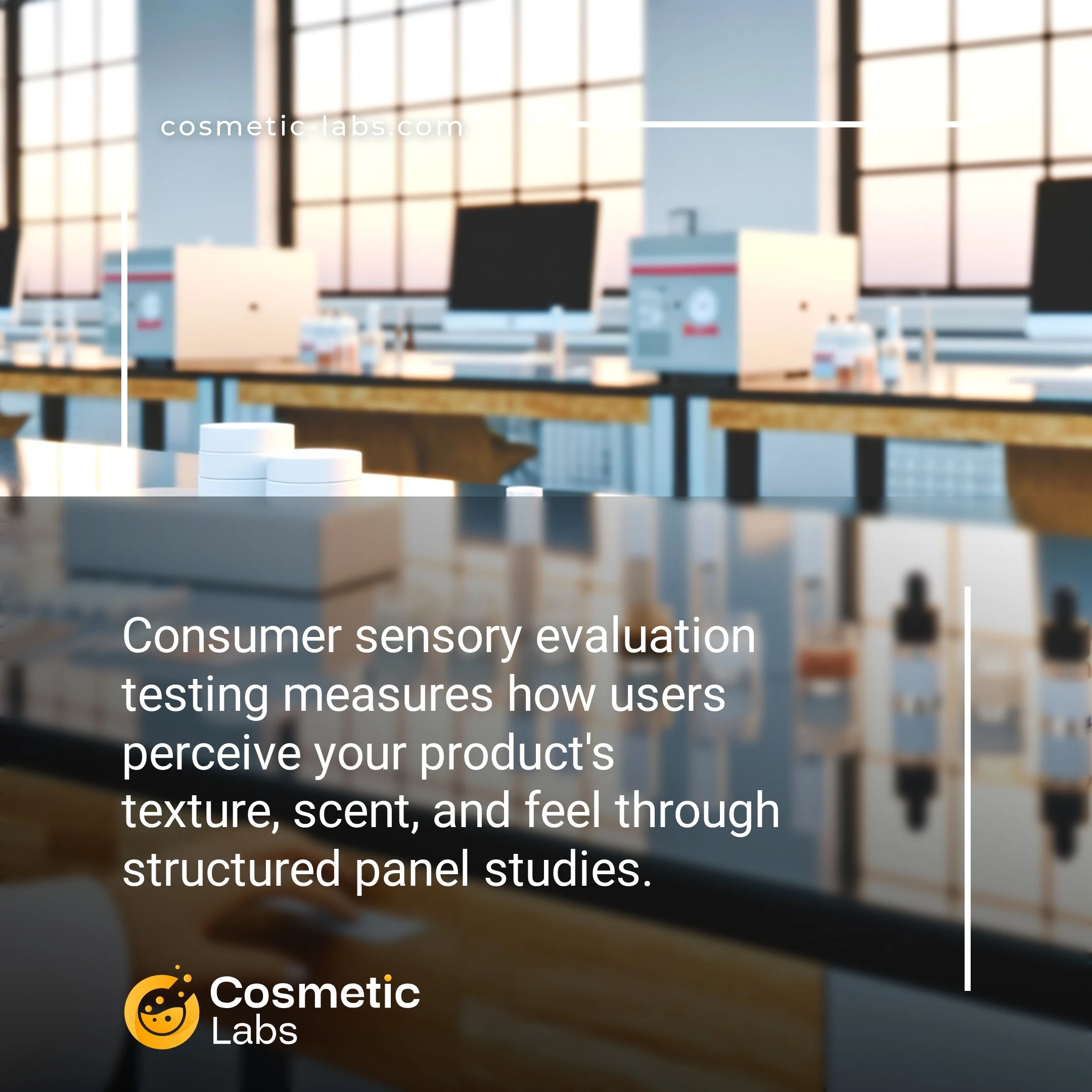Consumer Sensory Testing Services for Beauty Products

What is Consumer sensory evaluation testing?
Consumer sensory evaluation testing services measure how real users experience your cosmetic products through structured panels that assess texture, fragrance, appearance, and overall satisfaction. Labs conduct these studies with 50-200 participants who test products under controlled conditions, providing quantitative data on consumer preferences that helps you refine formulations before launch. This testing reveals which product attributes drive purchase decisions and identifies potential issues that internal teams might miss.
Why do you need this service?
Beauty brands use consumer sensory testing to validate texture preferences before launching moisturizers, serums, and cleansers, preventing costly reformulations after market release. Labs conduct blind texture comparisons and fragrance preference studies that reveal which formulations consumers actually prefer over competitors, delivering data-driven insights that guide final product decisions and marketing claims.
Who provides Consumer sensory evaluation testing services?
All cosmetic labs providing Consumer sensory evaluation testing services
There is no company providing these services at the moment.
Consumer Sensory Evaluation Testing Services
Consumer sensory evaluation testing bridges the gap between product development and market acceptance by measuring how real consumers perceive your cosmetic products. These services go beyond basic clinical testing to capture authentic user experiences with texture, fragrance, appearance, and overall product satisfaction.
Sensory Panel Testing and Consumer Preference Studies
Labs recruit trained sensory panels and consumer groups to evaluate your products through structured testing protocols. Participants assess attributes like spreadability, absorption rate, skin feel, and scent intensity using standardized rating scales. Triangle tests compare formulations to identify noticeable differences, while preference ranking helps determine which variants consumers favor most.
Testing typically includes:
- Texture analysis for creams, serums, and makeup products
- Fragrance evaluation and longevity assessment
- Color matching and visual appeal studies
- Application ease and product performance ratings
Usage Testing and Consumer Acceptance Validation
Home-use testing places products with target consumers for 2-4 weeks to capture real-world performance data. Participants document daily experiences through questionnaires and diaries, providing insights into product satisfaction, repurchase intent, and usage patterns. Labs analyze this feedback to identify formulation improvements and positioning opportunities.
Acceptance threshold testing determines minimum performance standards consumers expect from your product category. This data helps refine formulations before launch and supports marketing claims with quantifiable consumer feedback.
Connect with experienced cosmetic labs on our platform to design sensory evaluation studies that validate your product’s market potential and consumer appeal.
Practical Applications of Consumer Sensory Evaluation Testing
Beauty brands use consumer sensory evaluation testing applications to validate product performance claims and optimize formulations based on real user feedback before market launch.
Product Development and Formulation Optimization
Labs conduct texture analysis testing to measure viscosity, spreadability, and absorption rates for skincare products. Teams evaluate how different emulsifiers affect cream texture or how particle size impacts foundation blendability. Sensory panels rate attributes like greasiness, stickiness, and skin feel using standardized scales.
This testing identifies formulation issues early. A moisturizer might score poorly on absorption speed, prompting chemists to adjust humectant ratios. Labs test 3-5 formula variations simultaneously, comparing consumer preference scores to determine the winning formulation.
Claims Validation and Market Positioning
Brands validate marketing claims through controlled sensory studies. Labs recruit target demographics to test “long-lasting” lipsticks or “non-greasy” sunscreens against competitor products. Participants rate products on specific attributes using 9-point hedonic scales.
Results support advertising claims with statistical backing. A face serum claiming “instant hydration” needs consumer data showing immediate moisture improvement. Labs provide detailed reports with significance testing that legal teams use for claim substantiation.
| Testing Method | Application | Timeline | Panel Size |
|---|---|---|---|
| Triangle Test | Detect formula differences | 2-3 days | 30-50 participants |
| Preference Ranking | Compare multiple variants | 1 week | 75-100 participants |
| Descriptive Analysis | Profile sensory attributes | 2-3 weeks | 8-12 trained panelists |
| Consumer Acceptance | Market readiness assessment | 2-4 weeks | 100-300 participants |
Ready to validate your product’s sensory profile? Contact cosmetic labs on our platform to discuss your consumer testing requirements and get detailed quotes for your specific evaluation needs.
